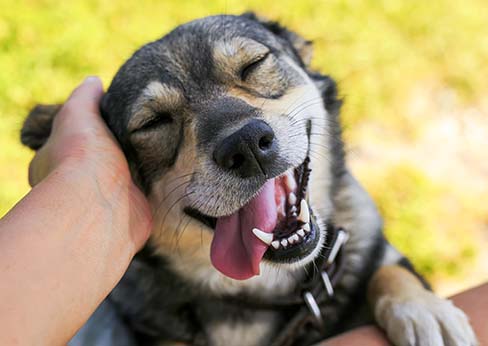You know exactly how you feel about your dog. You love them to pieces and would do anything for them! But do you know how your dog feels about you? Sure, they wag their tails and look happy when we get home from work, but do they actually feel love for us?
Many scientists have tried to answer this exact question!
One study focussed on the dog’s strongest sense – smell. A team of scientists did an MRI scan on twelve dogs who were presented with different smells. These smells included the smell of other dogs, food, and the smell of the dog’s owner. The study showed that when the dogs were presented with the smell of their human, their brain lit up in an area that experiences happiness and love.
That area of the brain is called the caudate nucleus, and it’s also present in human brains! The caudate nucleus controls approach-attachment behavior. This can range from a plain approach to a target to romantic love. It is shown to be active in people who are currently in love with another person, and it is a part of our reward systems.
When the dogs in this study were presented with their owner’s smell, the caudate nucleus was at its maximum potential. This indicates that dogs can experience feelings of love for us! Well, at least for our smells anyway.
Another thing we have in common with dogs in the ability to produce oxytocin. Oxytocin is a chemical produced by the brain that helps people form emotional bonds with others. Oxytocin is associated with our feelings of love, which can mean that the more social or friendly a dog is to a person, the more of this hormone has been released.
We’re both also able to produce dopamine! Love is associated with the dopaminergic reward system. Dopamine controls the brain’s reward and pleasure centers. People with low dopamine activity are a lot more likely to be addicts. It has been proposed that romantic love stems from this reward system.
A study by Ortigue shows that when a person falls in love the brain releases oxytocin, which is sometimes called the “love hormone”. It has been shown to play a huge role in maternal bonding, reducing stress, and that it plays a role in social synchrony and cooperation. So if we look at love as a combination of hormones and brain activity, then hypothetically dogs should be able to experience it as an emotion!
Another team of scientists decided to look into this hypothesis and study the connection between dogs and oxytocin. This is the first study to suggest that dog sociality toward people is related to polymorphisms in the OXTR (oxytocin receptor) gene.
Eighteen adult humans and eighteen canines were recruited to participate in this study. Participant’s oxytocin levels were measured upon arrival after they had been reading and just sitting in the room for ten minutes. The participants then interacted with one of the dogs from the study. The working hypothesis was that there would be no change in blood pressure or hormone levels. However, the research showed that there was an increase in oxytocin and dopamine levels in dogs and people after a positive interaction!
Another, similar study on German Shepherds and Border Collies concluded that a dog’s social behavior towards humans is influenced by the oxytocin system. This study took DNA samples from the dogs before and after they had an interaction with humans. The samples were then analyzed for the behaviors traits that were exhibited by the dogs towards humans.
The study suggests that oxytocin receptor gene polymorphisms have an impact on proximity to unfamiliar humans and on how friendly the dogs were toward the human. That means if an unfamiliar human approached, the dog’s brain would release less oxytocin. However, when a familiar person approached, the dog’s oxytocin levels increased.
Behavioral specialist Marc Bekoff concludes that strong emotions like happiness and love are what keeps social animals like dogs and humans together. It helps motivate the individuals in the group to protect and support each other. Dogs are pack animals, and humans have always done better when we’re living in a group.
While more research needs to be done, these studies have shown us what we suspected all along; our dogs love us just as much as we love them!





